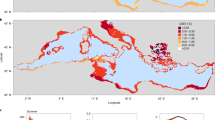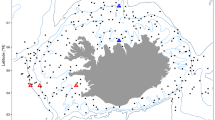Abstract
Understanding the fluctuations in marine fish stocks is important for the management of fisheries, and attempts have been made to demonstrate links with oceanographic and climatic variability1,2,3, including the North Atlantic Oscillation (NAO)4,5. The NAO has been correlated with a range of long-term ecological measures6,7, including certain fish stocks8,9. Such environmental influences are most likely to affect susceptible juveniles10 during estuarine residency, as estuaries are critical juvenile nursery or over-wintering habitats11. Here we show that, during a 16-year period, climatic forcing (by means of the NAO) is consistently the most important parameter explaining variation in assemblage composition, abundance and growth of juvenile marine fish during estuarine residency. A possible mechanism for the effect of the NAO is a temperature differential between estuarine and marine waters that allows fish to facultatively exploit optimal thermal habitats. The connection has potentially important implications for the size and numbers of individuals recruited to the fishery, for understanding and predicting the composition of juvenile fish stocks using estuaries, and for the appropriate conservation of estuarine systems in relation to fish stocks.
This is a preview of subscription content, access via your institution
Access options
Subscribe to this journal
Receive 51 print issues and online access
$199.00 per year
only $3.90 per issue
Buy this article
- Purchase on Springer Link
- Instant access to full article PDF
Prices may be subject to local taxes which are calculated during checkout


Similar content being viewed by others
References
Corten, A. & van de Kamp, G. Variation in the abundance of southern fish species in the southern North Sea in relation to hydrography and wind. ICES J. Mar. Sci. 53, 1113–1119 (1996).
Alheit, J. & Hagen, E. Long-term climate forcing of European herring and sardine populations. Fish. Oceanogr. 6, 130–139 (1997).
O'Brien, C. M., Fox, C. J., Planque, B. & Casey, J. Climate variability and North Sea cod. Nature 404, 142 (2000).
Rogers, J. C. The association between the North Atlantic Oscillation and the Southern Oscillation in the northern hemisphere. Mon. Weath. Rev. 112, 1999–2015 (1984).
Hurrell, J. W. Decadal trends in the North Atlantic Oscillation: regional temperature and precipitation. Science 269, 676–679 (1995).
Reid, P. C., Planque, B. & Edwards, M. Is observed variability in the long-term results of the Continuous Plankton Recorder survey a response to climate change? Fish. Oceanogr. 7, 282–288 (1998).
Ottersen, G. et al. Ecological effects of the North Atlantic Oscillation. Oecologia 128, 1–14 (2001).
Dippner, J. W. Recruitment success of different fish stocks in the North Sea in relation to climate variability. Ger. J. Hydrogr. 49, 277–293 (1997).
Hovgård, H. & Buch, E. in Large Marine Ecosystems: Patterns, Processes and Yields (eds Sherman, K., Alexander, L. M. & Gold, B. D.) 36–43 (American Association for the Advancement of Science (AAAS), Washington, 1992).
Wootton, R. J. Ecology of Teleost Fishes (Chapman & Hall, London, 1990).
Blaber, S. J. M. & Blaber, T. G. Factors affecting the distribution of juvenile estuarine and inshore fishes. J. Fish Biol. 17, 143–162 (1980).
Haddon, M. Modelling and Quantitative Methods in Fisheries (Chapman & Hall/CRC, Boca Raton, Florida, 2001).
Hilborn, R. & Walters, C. J. Quantitative Fisheries Stock Assessment (Chapman & Hall, London, 1992).
Brander, K. M. The effects of temperature on growth of Atlantic cod (Gadus morhua L.). ICES J. Mar. Sci. 52, 1–10 (1995).
Drinkwater, K. F. & Myers, R. A. Testing predictions of marine fish and shellfish landings from environmental variables. Can. J. Fish. Aquat. Sci. 44, 1568–1573 (1987).
Rodwell, M. J., Rodwell, D. P. & Folland, C. K. Oceanic forcing of the wintertime North Atlantic Oscillation and European climate. Nature 398, 320–323 (1999).
Power, M., Attrill, M. J. & Thomas, R. M. Temporal abundance patterns and growth of juvenile herring and sprat from the Thames estuary 1977–1992. J. Fish Biol. 56, 1408–1426 (2000).
Attrill, M. J. & Power, M. Effects on invertebrate populations of drought-induced changes in estuarine water quality. Mar. Ecol. Prog. Ser. 203, 133–143 (2000).
Power, M., Attrill, M. J. & Thomas, R. M. Environmental factors and interactions affecting the temporal abundance of juvenile flatfish in the Thames Estuary. J. Sea Res. 43, 135–149 (2000).
Thomas, R. M. in A Rehabilitated Estuarine Ecosystem: the Environment and Ecology of the Thames Estuary (ed. Attrill, M. J.) 115–140 (Kluwer, Dordrecht, 1998).
Kröncke, I., Dippner, J. W., Heyen, H. & Zeiss, B. Long-term changes in macrofaunal communities off Nordeney (East Frisia, Germany) in relation to climate variability. Mar. Ecol. Prog. Ser. 167, 25–36 (1998).
Blaxter, J. H. S. & Hunter, J. R. The biology of clupeoid fishes. Adv. Mar. Biol. 20, 1–224 (1982).
Wheeler, A. The Fishes of the British Isles and North West Europe (Michigan State Univ. Press; Macmillan, London, 1969).
Bettoso, N. & Dulcic, J. First record of the oilfish Ruvettus pretiosus in the northern Adriatic Sea. J. Mar. Biol. Ass. UK 79, 1145–1146 (1999).
Potter, I. C., Gardner, D. C. & Claridge, P. N. Age composition, growth, movements, meristics and parasites of the whiting Merlangius merlangus, in the Severn Estuary and Bristol Channel. J. Mar. Biol. Ass. UK 68, 295–313 (1988).
Elliott, M. & Taylor, C. J. L. in Proceedings of the 21st European Marine Biology Symposium, Gdansk, 14–19, September 1986 (eds Klekowski, R. Z., Styczynska-Jurewicz, E. & Falkowski, L.) 227–240 (Olsen and Olsen, Fredensborg, 1989).
Hutchings, J. A. Collapse and recovery of marine fisheries. Nature 406, 882–885 (2000).
Acknowledgements
We thank the Environment Agency for permission to analyse and publish the data. Support for completion of the work was provided by an NSERC research grant to M.P.
Author information
Authors and Affiliations
Corresponding author
Ethics declarations
Competing interests
The authors declare that they have no competing financial interests.
Supplementary information
41586_2002_BF417275a_MOESM1_ESM.pdf
Details of sampling and statistical methodology, with full results of analysis and discussion with references (PDF 66 kb)
Rights and permissions
About this article
Cite this article
Attrill, M., Power, M. Climatic influence on a marine fish assemblage. Nature 417, 275–278 (2002). https://doi.org/10.1038/417275a
Received:
Accepted:
Issue Date:
DOI: https://doi.org/10.1038/417275a
This article is cited by
-
Group size varies with climate and oceanographic conditions in bottlenose dolphins
Marine Biology (2023)
-
Impacts of chemical stress, season, and climate change on the flounder population of the highly anthropised Seine estuary (France)
Environmental Science and Pollution Research (2022)
-
Abundance and Diversity of Fish Assemblages Along the River-Estuary Continuum in a Fluvially Dominated Southern African Coastal System
Estuaries and Coasts (2021)
-
Structure and distribution of fish assemblages at Burdwood Bank, the first Sub-Antarctic Marine Protected Area “Namuncurá” in Argentina (Southwestern Atlantic Ocean)
Polar Biology (2020)
-
Community-based management induces rapid recovery of a high-value tropical freshwater fishery
Scientific Reports (2016)
Comments
By submitting a comment you agree to abide by our Terms and Community Guidelines. If you find something abusive or that does not comply with our terms or guidelines please flag it as inappropriate.



